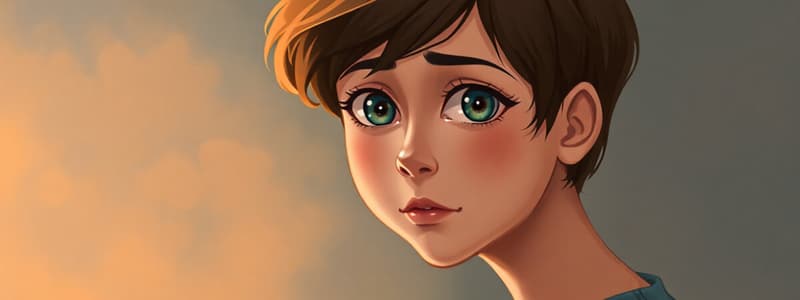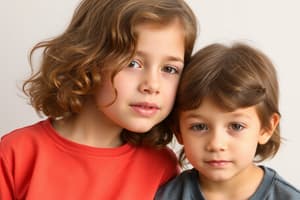Podcast
Questions and Answers
What is the primary purpose of ultrasound scans during pregnancy?
What is the primary purpose of ultrasound scans during pregnancy?
- To predict the baby's gender
- To monitor the baby's growth and health (correct)
- To prepare for childbirth
- To ensure the baby is born on time
Girls usually start puberty at the same age as boys.
Girls usually start puberty at the same age as boys.
False (B)
What happens to boys' bodies during puberty?
What happens to boys' bodies during puberty?
Boys become more muscular, their penis and testes grow bigger, shoulders widen, voice deepens, and hair grows in various areas.
The time from fertilization to birth is known as __________.
The time from fertilization to birth is known as __________.
Which hormone is responsible for triggering puberty changes?
Which hormone is responsible for triggering puberty changes?
What are the roles of ovaries in girls during puberty?
What are the roles of ovaries in girls during puberty?
Match the following terms with their definitions:
Match the following terms with their definitions:
During fertilization, the sperm meets the egg in the __________.
During fertilization, the sperm meets the egg in the __________.
What is the function of the testes in the male reproductive system?
What is the function of the testes in the male reproductive system?
The egg cell is released from the ovaries during menstruation.
The egg cell is released from the ovaries during menstruation.
What are the main methods of seed dispersal?
What are the main methods of seed dispersal?
The ________ is the tube that carries urine and sperm out of the male body.
The ________ is the tube that carries urine and sperm out of the male body.
What happens if the egg is not fertilised during the menstrual cycle?
What happens if the egg is not fertilised during the menstrual cycle?
Contraceptive pills provide protection against sexually transmitted infections (STIs).
Contraceptive pills provide protection against sexually transmitted infections (STIs).
What is the normal duration of a menstrual period?
What is the normal duration of a menstrual period?
During the menstrual cycle, if pregnancy occurs the egg attaches to the ________ of the uterus.
During the menstrual cycle, if pregnancy occurs the egg attaches to the ________ of the uterus.
What is the primary role of glands in the male reproductive system?
What is the primary role of glands in the male reproductive system?
At what week does the sense of touch begin to develop in the fetus?
At what week does the sense of touch begin to develop in the fetus?
Smoking during pregnancy can lead to premature birth.
Smoking during pregnancy can lead to premature birth.
What is the primary function of the placenta?
What is the primary function of the placenta?
The _______ connects the fetus to the placenta.
The _______ connects the fetus to the placenta.
Which of the following statements about germination is true?
Which of the following statements about germination is true?
Insect-pollinated plants do not produce nectar.
Insect-pollinated plants do not produce nectar.
What two main processes must happen for a new organism to be created?
What two main processes must happen for a new organism to be created?
The _______ releases sperm during ejaculation.
The _______ releases sperm during ejaculation.
Match the following structures with their functions:
Match the following structures with their functions:
What is the first step in the birth process?
What is the first step in the birth process?
The embryo attaches to the lining of the uterus in a process called fertilization.
The embryo attaches to the lining of the uterus in a process called fertilization.
Which two methods can transfer pollen?
Which two methods can transfer pollen?
The _______ from the anther must transfer to the stigma for pollination to occur.
The _______ from the anther must transfer to the stigma for pollination to occur.
What happens to the ovary after fertilization?
What happens to the ovary after fertilization?
Alcohol consumption during pregnancy can influence brain development.
Alcohol consumption during pregnancy can influence brain development.
Flashcards
Adolescence
Adolescence
The period of time between childhood and adulthood, marked by significant physical, emotional, and social changes.
Puberty
Puberty
The process of physical changes that occur in the body during adolescence, leading to sexual maturity.
Sex Hormones
Sex Hormones
Chemical messengers produced by the body that trigger changes during puberty.
Fertilization
Fertilization
Signup and view all the flashcards
Implantation
Implantation
Signup and view all the flashcards
Gestation
Gestation
Signup and view all the flashcards
Sperm Cell Journey
Sperm Cell Journey
Signup and view all the flashcards
Embryonic Development (1 Week)
Embryonic Development (1 Week)
Signup and view all the flashcards
Male Reproductive System
Male Reproductive System
Signup and view all the flashcards
Female Reproductive System
Female Reproductive System
Signup and view all the flashcards
Sperm Cells
Sperm Cells
Signup and view all the flashcards
Egg Cells
Egg Cells
Signup and view all the flashcards
Menstrual Cycle
Menstrual Cycle
Signup and view all the flashcards
Ovulation
Ovulation
Signup and view all the flashcards
Condom
Condom
Signup and view all the flashcards
Contraceptive Pill
Contraceptive Pill
Signup and view all the flashcards
Contraception
Contraception
Signup and view all the flashcards
Cilia
Cilia
Signup and view all the flashcards
Ejaculation
Ejaculation
Signup and view all the flashcards
Embryo
Embryo
Signup and view all the flashcards
Sperm duct
Sperm duct
Signup and view all the flashcards
Oviduct
Oviduct
Signup and view all the flashcards
Testes
Testes
Signup and view all the flashcards
Ovaries
Ovaries
Signup and view all the flashcards
Pollination
Pollination
Signup and view all the flashcards
Germination
Germination
Signup and view all the flashcards
Fruit
Fruit
Signup and view all the flashcards
Ovule
Ovule
Signup and view all the flashcards
Stigma
Stigma
Signup and view all the flashcards
Study Notes
Adolescence
- Adolescence is the transition from childhood to adulthood, marked by emotional and physical changes
- Emotional changes include mood swings, irritability, and experimentation with risky behaviors like alcohol
- Puberty, the physical changes, occurs between ages 9-14, with girls typically starting earlier than boys
- Puberty primarily affects the reproductive system, allowing for future reproduction
- Sex hormones (chemical messengers) drive puberty
- Female hormones are produced in the ovaries; male hormones in the testes
- These hormones trigger changes throughout the body
Puberty Changes
- Both boys and girls: Hair growth (underarms, pubic), height increase, increased body odor, and emotional changes
- Girls: Breast development, vaginal hair, egg production begins, menstruation starts, widening hips, production of female sex hormones
- Boys: Increased muscle mass, penis and testicle growth, production of sperm and male sex hormones, shoulder broadening, deepening voice, facial, arm, leg and underarm hair growth
Fetal Development
- Fertilization: Sperm and egg unite to form a zygote
- Implantation: Fertilized egg attaches to the uterine wall
- Gestation: The period from fertilization to birth (approximately 9 months/40 weeks)
- Ultrasound Scans: Used to monitor growth, detect abnormalities, and check position/health
- Early Development:
- 1 week: Cell specialization begins
- 4 weeks: Spine, brain formation, heart begins beating
- 9 weeks: Movement, touch sensation, eye and ear development
- 12 weeks: Muscle activity (kicking, swallowing), breathing practice
Support Structures
- Placenta: Facilitates nutrient/waste exchange between mother and fetus; acts as a barrier against infection
- Umbilical Cord: Connects the fetus to the placenta
- Amniotic Fluid: Cushions and protects the fetus
Factors Affecting Fetal Development
- Smoking: Leads to premature birth
- Alcohol: Negatively impacts brain development
- Drugs: Harm fetal growth and organ formation
Birth Process
- Uterine contractions expel the baby through the vagina
- Umbilical cord is cut
- Placenta (afterbirth) is delivered
Fertilization and Germination
- Pollination: Transfer of pollen from the anther to the stigma
- Methods of Pollination: Wind or insects
- Insect vs. Wind Pollination: Insect-pollinated flowers are usually brightly colored, scented, and have nectar; wind-pollinated flowers are typically dull and small
- Fertilization: Union of pollen (male gamete) and ovum (female gamete)
- Germination: Seed growth requiring water, oxygen, and warmth
Parts of a Plant (for Reproduction)
- Anther: Produces pollen
- Stigma: Receives pollen
- Style: Tube connecting stigma to ovary
- Ovule: Female reproductive cell; becomes seed after fertilization
- Ovary: Surrounds ovules and develops into fruit after fertilization
- Pollination brings pollen from anther to stigma initiating the fertilization process.
- Fertilization occurs when the pollen unites with the ovule
- Seeds form inside the fruit
Fertilization and Implantation
- Fertilisation: Sperm and egg uniting
- Gametes: Reproductive cells (sperm and egg) needing to combine
- Cilia: Tiny hairs in the oviducts helping move the egg
- Ejaculation: Semen release, essential for fertilization
- Embryo: Fertilized egg dividing into a ball of cells
- Implantation: Embryo attachment to the uterine wall
Reproductive Systems
- Male Reproductive System:
- Testes: Produce sperm and hormones
- Glands: Provide nutrients for sperm (semen)
- Sperm ducts: Transport sperm
- Urethra: Transfers urine and semen
- Penis: Delivers semen
- Sex, or a sexual nature, is an expression of desire or arousal, in intimate relationships, involving pleasure
Seed Dispersal
- Seed dispersal mechanisms include wind, animals, water, and explosive methods
- Seed dispersal ensures available space for growth and prevents competition for resources
Menstrual Cycle
- Menstruation: Uterine lining shedding (monthly bleeding) lasting 3-7 days
- Menstrual Cycle: A 28-day sequence of hormonal changes preparing the uterus for a potential pregnancy.
- Ovulation: Egg release from the ovary
- Hormones: Control the menstrual cycle
- Pregnancy Prevention: Methods like condoms and the pill to avoid pregnancy
- Condom use: Prevents pregnancy and STIs via a barrier; protects both man and woman
- Pill use: Precludes pregnancy by suppressing ovulation; however, it provides no protection from STIs
Studying That Suits You
Use AI to generate personalized quizzes and flashcards to suit your learning preferences.




